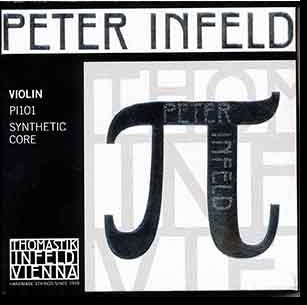Thomastik Infeld
Thomastik Infeld Violin 4/4 String Set with Tin Plated E String - PI101
Thomastik Infeld Violin 4/4 String Set with Tin Plated E String - PI101
SKU:SPI101
Couldn't load pickup availability
Infeld
A new generation of strings:
Infeld Violin
Up till now violinists have influenced the sound of individual strings, and of their violin as a whole, by using a mix of strings with different gradations of tension (high, middle, low), or even using strings from different manufacturers. Due to the entirely different characteristics of individual strings, both strategies strongly affected the tonal balance of the instrument, forcing the violinist or the violin maker to optimize the instrument by a laborious process of trial and error. Different strings meant that different times were required to play in the strings, and that their playing life-spans differed. Response characteristics were also uneven. The result was that for the violinist the string set did not behave as balanced whole, each string responding unequally to his or her playing. With Thomastik-Infeld's new concept Infeld Violin, string types can be changed at will, allowing the violinist to affect the overall tonal balance of his or her instrument with ease yet retaining smoothly matched playing characteristics.
At present there are two additional types of Infeld Violin strings, whereby the red set will produce a rather dark sound on the majority of violins, while the blue set will tend to bring out the instrument's brilliance. Tonal balance, playing characteristics at any given position and string response are excellent throughout. This is possible due to homogenous string tension at various pitches and design parameters which balance the overall behaviour of the set irrespective of the combination of strings. Using the INFELD VIOLIN system, both the violinist and the violin maker will find that the instrument can be optimized in a very short time.
The Infeld Violin system affords the player a list of advantages:
- suitable for old and new instruments.
- relatively insensitive to excess humidity.
- strings settle in quickly, stabilising early on in the string's life for concert use.
- low overall tension on the instrument produces an open, transparent sound.
- very responsive to different playing techniques, lending itself to various interpretative approaches.
- large and full sound, making the string sets suitable for soloists and chamber music players.
- good purity of open fifths, even when strings are older.
- excellent response in all positions.
- the set emphasises the innate tonal characteristics of each violin, making instrument adjustment easier.
The central problem is that some violins react very sensitively to various thicknesses of E string. Our recommendation when changing strings is to start with the E string. The E string provided with the set represents a good choice for the majority of instruments. (Incidentally, the E string's ball end can be removed by finger pressure, so that the string can be used with a ball end or loop end as required). Now the G string should be changed, then the D string and finally the A string.
Technical Characteristics:
There are two kinds of E strings. The gold-plated E strings are manufactured using a special process, which considerably improves their performance and sound in relation to conventional gold-plating methods. The 'silver' E strings are galvanised, which allows their sound characteristcs to come to the fore unimpaired. The rest of the strings have a composite core, which fulfills all the functional characteristcs expected of a great string. The first winding of the string consists of a alloy which actually occurs in Nature, which is why it is designated as 'Natural Alloy'. Already centuries ago this type of alloy was regarded as having special properties. The G string is wound in pure silver, assuring optimum density. The A and D strings are wound with an alloy called hydronalium, which makes for good bow contact and excellent balance between bowing noise and resultant string sound.
Share












